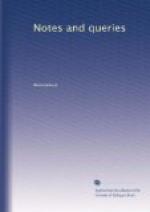George Wither, the Poet, a Printer (Vol. ii., p. 390.).—In addition to DR. RIMBAULT’S extract from Wither’s Britain’s Remembrancer, showing that he printed (or rather composed) every sheet thereof with his own hand, I find, in a note to Mr. R.A. Willmott’s volume of the Lives of the English Sacred Poets, in that interesting one of George Wither, the following corroboration of this singular labour of his: the poem, independent of the address to the King and the praemonition, consisting of between nine and ten thousand lines, many of which, I doubt not, were the production of his brain while he stood at the printing-case. A MS. note of Mr. Park’s, in one of the many volumes of Wither which I possess, confirms me in this opinion.
“Ben Jonson, in Time Vindicated, has satirized the custom, then very prevalent among the pamphleteers of the day, of providing themselves with a portable press, which they moved from one hiding-place to another with great facility. He insinuates that Chronomastix, under whom he intended to represent Wither, employed one of these presses. Thus, upon the entrance of the Mutes,—
“Fame. What are this pair?
Eyes. The ragged rascals?
Fame. Yes.
Eyes. These rogues; you’d
think them rogues,
But they are friends;
One is his printer
in disguise, and keeps
His press in a
hollow tree.”
From this extract it should seem that Wither not only composed the poem at case (the printer’s phrase), but worked it off at press with his own hands.
J.M.G.
Worcester.
“Preached as a dying Man to dying Men” (Vol. i., p. 415.; Vol. ii., p. 28.).—Some time ago there appeared in this series (Vol. i., p. 415.) a question respecting a pulpit-phrase which has occasionally been used by preachers, delivering their messages as “dying men to dying men.” This was rightly traced (Vol. ii., p. 28.) to a couplet of the celebrated Richard Baxter, who, in one of his latest works, speaking of his ministerial exercises, says,—
“I preach’d as never sure
to preach again,
And as a dying man to dying men.”
The passage occurs in one of his “Poetical Fragments,” entitled “Love breathing Thanks and Praise.”
This small volume of devotional verse is further entitled, Heart Imployment with GOD_ and Itself; the concordant Discord of a Broken-healed Heart; Sorrowing, Rejoicing, Fearing, Hoping, Dying, Living: published for the Use of the Afflicted_. The Introduction is dated “London: at the Door of Eternity, Aug. 7. 1681.”
He yet survived ten years, in the course of which he was twice imprisoned and fined under {37} the profligate and persecuting reigns of Charles II. and James II. for his zeal and piety.
J.M.G.
Hallamshire.
Authors of Anonymous Works.—On the title-page of the first volume of my copy of The Monthly Intelligencer for 1728 and 1729, which was published anonymously, is written in MS., “By the Rev. Mr. Kimber.”




